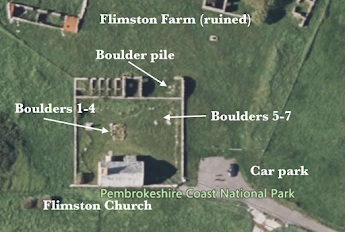Today, in perfect early summer weather, we spent a happy hour mooching about in Flimston Churchyard, looking at erratics. And very fine they are too........
There are seven big erratic boulders in the churchyard, four of them in a row near the stone cross monument, used as memorial stones or headstones for members of the Lambton family. Grid ref: SR 92386 95590. In the following notes they are numbered as on the photo above. They are on the west side of a slightly raised mound which marks the grave sites, bounded by smaller limestone boulders gathered locally. The other three erratic boulders are about 15 metres away, in the NE corner of the churchyard. Grid ref: SR 92403 95595. They are recumbent, and were probably brought here with the intention of using them as headstones -- but they were never used. All seven of the boulders were gathered up from the surrounding area -- the most distant about 3.4 km away.
These are not the only Flimston erratics. There are several small igneous erratic boulders in the walls around the churchyard, and over the wall, in the NE corner, there is a pile of small boulders, at least ten of which appear to be igneous. Grid ref: SR 92407 95604. At one time, this was a roofed farm building (the ruined Flimston Farm is immediately adjacent) and I think the boulders were probably dumped here following field clearance.
The pile of "field clearance" boulders just outside the churchyard wall. At least ten of them are igneous.BOULDER 2 (FWL)
BOULDER 3 (GCL)
BOULDER 4 (CAL)
This (no 3 of HHT) is the most massive of the boulders, not elongated, and probably not deeply embedded in the surface. Dimensions 90 x 90 x 80 cms. Heavily abraded, with no signs of fractures, but some very old and abraded facets and surface pitting. Edges all rounded off. A blue-grey colour -- unspotted dolerite or diorite similar to boulder 2, but appears more fine-grained. Referred to as a diabase by HHT. Found at Merrion Pond, about 2 km to NE, grid ref SR 937 971. Source: probably one of the PreCambrian outcrops on the north or south shore of St Brides Bay?
THE CLUSTER OF THREE
This is a large rough boulder, recumbent, with dimensions 110 x 90 x 60 cms. Some large fracture scars, including one on the uppermost surface. Another welded tuff or pyroclastic ashflow rock -- many brecciated fragments but not as "spherulitic" as boulder number 1. Dark blue colouring. Found at Lyserry Farm or Valast Hill Farm, 3.4 km ENE, at grid ref SR 955 966. Is this HHT's stone no 3, "a quartz-porphyry with pink felspars" probably from a non-Welsh location?
BOULDER 6
A very large elongated boulder, recumbent, dimensions 180 x 90 x 55 cms. Light grey-blue colour. A rhyolite (?) or lava, but not as rough as boulder 3. Prominent fracture scars. Flattish undulating top. In places, a slightly orange colouration. A PreCambrian rhyolite from near Porth y Rhaw? Found at Lyserry Farm or Valast Hill Farm, 3.4 km ENE, at grid ref SR 955 966. This might be HHT's boulder no 5, "a quartz porphyry of unknown origin"? But we have no visual record of the boulders and their allocated numbers.
BOULDER 7
A smaller boulder, also recumbent. Dark blue or blackish colour -- dimensions 120 x 60 x 40 cms. Coarse texture -- possibly a gabbro. Some broken facets, but heavily weathered and again much of the surface covered with lichen growths. Found at Lyserry or Valast Hill Farm, 3.4 km ENE, at grid ref SR 955 966. This might be HHT's boulder No 4, referred to as "a diabase, probably from the Prescelly Mountains" -- but I think it looks more like the St Davids Head gabbro.
Conclusions
Each of these boulders appears unique -- I suggest that they have come from 7 different locations, most likely near the tip of St Davids Peninsula or Ramsey Island or the Bishops and Clerks. Could boulder 1 have travelled due south from the west side of Pen Caer? Not very likely, but not impossible........ And could boulders 5 and 6 have travelled from outside Wales? HH Thomas suggested that some of the erratics on the limestone flats of the Castlemartin Peninsula might have come from the uplands of Preseli -- including a big "spotted diabase" boulder in Loveston farmyard. However, I have not seen any evidence to support that suggestion.
Anyway, this is the first time these boulders have been systematically described. I hope this will encourage further research from those who are better qualified than I am in matters petrological!
======================
https://pubs.bgs.ac.uk/publications.html?pubID=B01825




















No comments:
Post a Comment